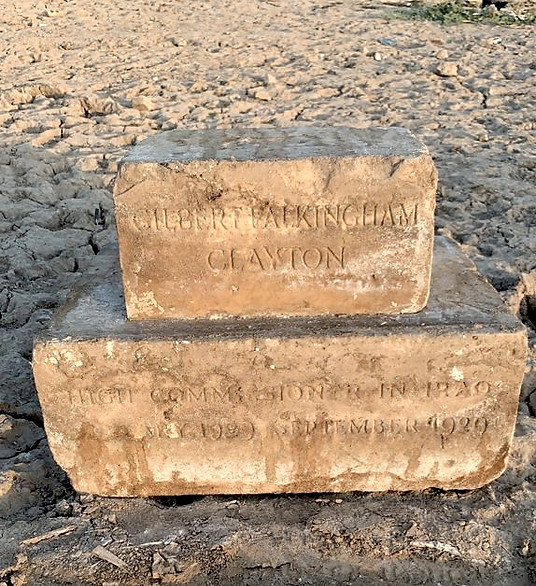

6 Sqn RAF, British Cemeteries in Iraq & WW1
Ma' Asker Al Raschid RAF Cemetery (Rasheed)
Hundreds of British and Commonwealth Air Force personnel died whilst serving in Mesopotamia, from the 30th July 1915 to the closing down of the last base at RAF Habbaniya on the 31st May 1959 at which time all British forces were withdrawn from Iraq. Due to British Government policy, no bodies were repatriated but instead were buried at various cemeteries in Iraq, with 300 burials recorded at the Hinaidi RAF Peace Cemetery, re-named Ma'Asker Al Raschid RAF Cemetery (more commonly referred to as the Rasheed Cemetery) when RAF Hinaidi was handed over to the Iraqi government in 1937. With the kind assistance of the late Peter Burlton (for many years the head researcher at the RAF Habbaniya Association who gave me access to his research notes as well as the official burial details kept by the Commonwealth War Graves Commission) coupled with 'on the ground' assistance provided by the British Embassy in Baghdad and hundreds of hours of my own research, I have been able to compile a service profile for most of the 197 RAF burials at Ma'Asker as well as basic details for the other 103 Army, Navy and civilian burials.
In November 2018 whilst researching a 6 Squadron RAF officer who was killed in action in Iraq 'between the wars' and was buried at Baghdad, I became aware of a long-abandoned RAF Cemetery at Hinaidi, the final resting place of 300 service personnel and civilians who died whilst serving in Iraq between 1921 and 1937. After a year of research and time-consuming but fruitless lobbying of various departments of the Royal Air Force, the Commonwealth War Graves Commission and the British Ministry of Defence, as a last resort I sought the help of the British High Commissioner to Iraq in Baghdad. Though my letter took five months to reach the British Embassy, I was contacted by the Defence Attaché Brigadier Adam McRae the very day it was received and we worked together as a team for the next two years two years on a project to secure the perimeter of the cemetery as a matter of urgency, thereby putting a halt to the progressive desecration of the graves, until such time as resources could be allocated by the CWGC/MoD for the restoration & replacement of the 300 headstones.
Pictured above is Brigadier Adam McRae standing in front of the headstone for 8 month old baby Phoebe Marks, who died on the 17th July 1929 of unknown causes. Her father, an electrician with the Royal Air Force, was also buried at Ma'Asker, after being shot by a disgruntled local on the 11th September 1934 and dying the following day.
Under the guidance of British Embassy staff and with the co-operation of the British Ministry of Defence and the Commonwealth War Graves Commission, Stage 1 of the project was completed at the end of October 2021, with a brick perimeter wall erected around the cemetery and a steel security gate installed in the Eastern wall with Commonwealth War Graves signage. A Remembrance Day service and re-dedication of the cemetery was held on site on November 11, Armistice Day, attended by Air Marshall Martin Sampson CDE, DSO, Defence Senior Advisor to the Middle East and Brigadier Adam McRae MBE, at that time the UK Defence Attaché to Iraq (both seen saluting in photograph below).
During the wall-building process, 71 headstones (partial or complete) were recovered and photographs of these can be seen by clicking HERE.
Stage 2, the restoration of the cemetery to its former glory by preparing the site and eventually reinstating or re-making the headstones, was then investigated, with the contractor tasked with Stage 1 providing costings by the end of 2022 for the levelling of the complete cemetery as well moving the existing headstones to one side of the new wall where they would be clearly displayed. Despite approval being given to proceed, a temporary halt was called by the JCCC until the CWGC and the MoD could set up a team (in the 2023/24 financial year) and decide upon whether to use sub-contractors or CWGC staff. In the meantime, a local caretaker was employed to keep an eye on the cemetery. (see photo below) Click HERE for more photographs of the Remembrance Day ceremonies for 2021, 2022 and 2023.
197 of the 300 graves at Ma'Asker are for Royal Air Force casualties from eight RAF squadrons (1, 6, 8, 30, 45, 55, 70 and 84) as well as a variety of other ground-based RAF Units. Forty-six (46) of the burials were for pilots who had served across a combined total of more than forty Royal Air Force squadrons during their air force career, with half of this number seasoned and decorated WW1 pilots, including 4 'Aces' and 3 aviation pioneers.
Apart from 197 RAF graves, there are 72 graves for British Army personnel (representing more than 20 Regiments, the RA/RFA and other British Army entities such as the Royal Signals and Army Services Corps) and 2 for Royal Navy men, a Chief Petty Officer from HMS Hastings and an Able Seaman from HMS Ormonde. There are also 29 graves for British civilian RAF contractors (24 men and 5 women) who were employed in various capacities in Baghdad and 1 grave for an 8-month-old baby girl, Phoebe Marks. However, the most significant grave at Hinaidi is for Brigadier-General Sir Gilbert Clayton KCMG KBE CB, British High Commissioner for Iraq, who died in September 1929 from a heart attack after a game of Polo.
The topics covered in this section of my website include the 2021 Remembrance Day re-dedication ceremony, old and present-day photographs of the cemetery layout, photographs of the seventy-one headstones that survived over the years, details and position of every grave as well as various searchable databases and statistics detailing the service records and honours (where applicable and/or available) for every man buried at Hinaidi.


